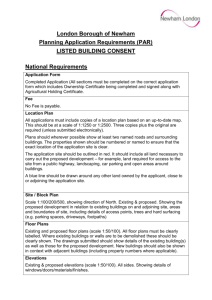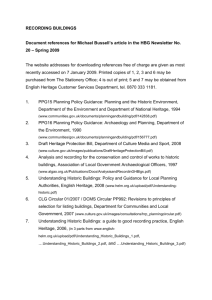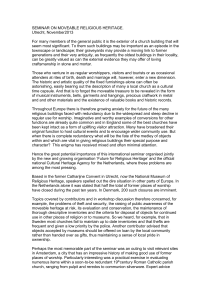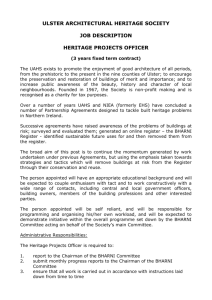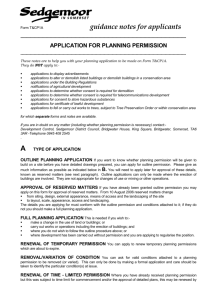Conservation area consent PAR
advertisement
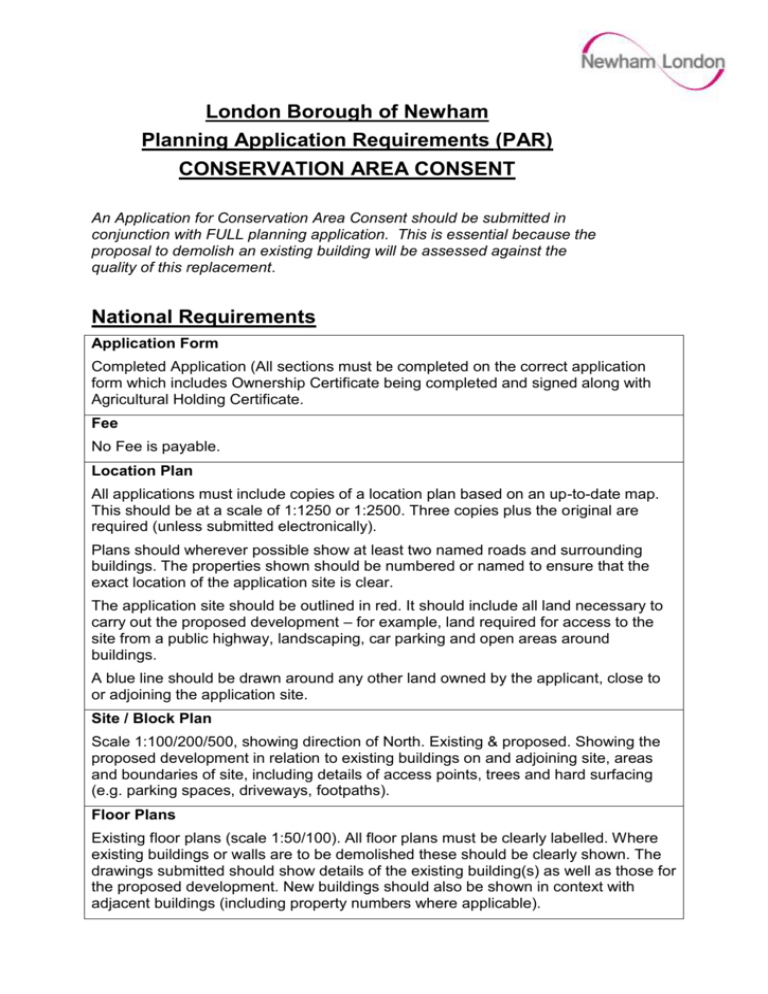
London Borough of Newham Planning Application Requirements (PAR) CONSERVATION AREA CONSENT An Application for Conservation Area Consent should be submitted in conjunction with FULL planning application. This is essential because the proposal to demolish an existing building will be assessed against the quality of this replacement. National Requirements Application Form Completed Application (All sections must be completed on the correct application form which includes Ownership Certificate being completed and signed along with Agricultural Holding Certificate. Fee No Fee is payable. Location Plan All applications must include copies of a location plan based on an up-to-date map. This should be at a scale of 1:1250 or 1:2500. Three copies plus the original are required (unless submitted electronically). Plans should wherever possible show at least two named roads and surrounding buildings. The properties shown should be numbered or named to ensure that the exact location of the application site is clear. The application site should be outlined in red. It should include all land necessary to carry out the proposed development – for example, land required for access to the site from a public highway, landscaping, car parking and open areas around buildings. A blue line should be drawn around any other land owned by the applicant, close to or adjoining the application site. Site / Block Plan Scale 1:100/200/500, showing direction of North. Existing & proposed. Showing the proposed development in relation to existing buildings on and adjoining site, areas and boundaries of site, including details of access points, trees and hard surfacing (e.g. parking spaces, driveways, footpaths). Floor Plans Existing floor plans (scale 1:50/100). All floor plans must be clearly labelled. Where existing buildings or walls are to be demolished these should be clearly shown. The drawings submitted should show details of the existing building(s) as well as those for the proposed development. New buildings should also be shown in context with adjacent buildings (including property numbers where applicable). Elevations Existing elevations (scale 1:50/100). All sides. Showing details of windows/doors/materials/finishes. Roof Plans To show the shape and materials of the existing roof(s) (scale 1:100). Sections & Site Levels (at a scale of 1:50 or 1:100) Where development involves a change in ground levels (scale 1:50 or 1:100) or if any of the elevations are obscured from view by existing structures plans should show a cross section(s) through the proposed building(s). This is particularly important if basement or loft accommodation is to be provided. If the proposal involves a change in ground levels, illustrative drawings should be submitted to show both existing and finished floor levels. Details demonstrating how the proposed buildings relate to existing site levels at neighbouring development are required Sections are always required for any works that go into roof space and ground floor extensions. Local Requirements Supporting documentation will vary according to the nature of the proposal. Heritage statement All applications for Listed Building Consent should be accompanied by a written heritage statement. This statement should include a schedule of works to the listed building(s), an analysis of the significance of archaeology, history and character of the building/ structure, the principles of and justification for the proposed works, and their impact on the special character of the listed building or structure, its setting and the setting of adjacent listed buildings. A structural survey may be required in support of an application that involves substantial demolition. All applications for Conservation Area Consent will require a written statement. That statement should provide any relevant structural information, an analysis of the character and appearance of the building/structure, the principles of, and justification for, the proposed demolition, and its impact on the special character of the area. For all applications either related to or impacting on the setting of heritage assets a written statement that includes plans showing historic features that may exist on or adjacent to the application site including listed buildings and structures, historic parks and gardens, historic battlefields and scheduled ancient monuments and an analysis of the significance of archaeology, history and character of the building/structure, the principles of and justification for the proposed works and their impact on the special character of the listed building or structure, its setting and the setting of adjacent listed buildings may be required. For all applications within or adjacent to a conservation area, an assessment of the impact of the development on the character and appearance of the area may be required. For all applications involving the disturbance of ground within an Area of Archaeological Priority, as defined in the development plan, or in other areas in the case of a major development proposal or significant infrastructure works, an applicant may need to commission an assessment of existing archaeological information and submit the results as part of the heritage statement. The scope and degree of detail necessary in a heritage statement will vary according to particular circumstances of each application. Applicants are advised to discuss proposals with either a planning officer or a conservation officer before any application is made. For heritage assets, advice is provided in Planning Policy Guidance Note 15 ‘Planning and the Historic Environment’, (September 1995) paragraphs 3.16 to 3.19 and 4.25 to 4.49. For archaeological remains, advice is provided in Planning Policy Guidance Note 16 ‘Archaeology and Planning’ (November 1990) section B, paragraphs 18 to 26.
